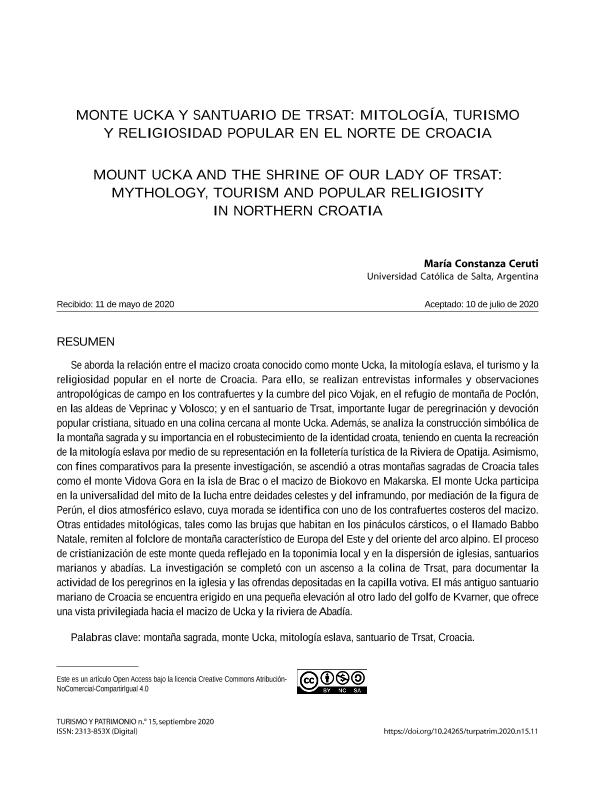Mostrar el registro sencillo del ítem
dc.contributor.author
Ceruti, Maria Constanza

dc.date.available
2021-09-28T15:56:32Z
dc.date.issued
2020-09
dc.identifier.citation
Ceruti, Maria Constanza; Monte Ucka y santuario de Trsat: mitología, turismo y religiosidad popular en el norte de Croacia; Universidad de San Martín de Porres. Facultad de Ciencias de la Comunicación, Turismo y Psicología; Turismo y Patrimonio; 15; 9-2020; 181-194
dc.identifier.issn
1680-9556
dc.identifier.uri
http://hdl.handle.net/11336/141725
dc.description.abstract
Se aborda la relación entre el macizo croata conocido como monte Ucka, la mitología eslava, el turismo y la religiosidad popular en el norte de Croacia. Para ello, se realizan entrevistas informales y observaciones antropológicas de campo en los contrafuertes y la cumbre del pico Vojak, en el refugio de montaña de Poclón, en las aldeas de Veprinac y Volosco; y en el santuario de Trsat, importante lugar de peregrinación y devoción popular cristiana, situado en una colina cercana al monte Ucka. Además, se analiza la construcción simbólica de la montaña sagrada y su importancia en el robustecimiento de la identidad croata, teniendo en cuenta la recreación de la mitología eslava por medio de su representación en la folletería turística de la Riviera de Opatija. Asimismo, con fines comparativos para la presente investigación, se ascendió a otras montañas sagradas de Croacia tales como el monte Vidova Gora en la isla de Brac o el macizo de Biokovo en Makarska. El monte Ucka participa en la universalidad del mito de la lucha entre deidades celestes y del inframundo, por mediación de la figura de Perún, el dios atmosférico eslavo, cuya morada se identifica con uno de los contrafuertes costeros del macizo. Otras entidades mitológicas, tales como las brujas que habitan en los pináculos cársticos, o el llamado Babbo Natale, remiten al folclore de montaña característico de Europa del Este y del oriente del arco alpino. El proceso de cristianización de este monte queda reflejado en la toponimia local y en la dispersión de iglesias, santuarios marianos y abadías. La investigación se completó con un ascenso a la colina de Trsat, para documentar la actividad de los peregrinos en la iglesia y las ofrendas depositadas en la capilla votiva. El más antiguo santuario mariano de Croacia se encuentra erigido en una pequeña elevación al otro lado del golfo de Kvarner, que ofrece una vista privilegiada hacia el macizo de Ucka y la riviera de Abadía.
dc.description.abstract
The relationship between the Croatian massif known as Mount Ucka, Slavic mythology, tourism and popular religiosity in northern Croatia is addressed in this paper. For this, informal interviews and anthropological field observations are carried out on the buttresses and the summit of Vojak Peak, in the Poclón mountain refuge, in the villages of Veprinac and Volosco; and in the sanctuary of Trsat, an important place of pilgrimage and popular Christian devotion, located on a hill near Mount Ucka. In addition, the symbolic construction of the sacred mountain and its importance in strengthening the Croatian identity are analyzed, taking into account the recreation of Slavic mythology through its representation in the tourist brochures of the Opatija Riviera. Also, for comparative purposes for the present investigation, other sacred mountains in Croatia such as Mount Vidova Gora on the island of Brac or the Biokovo massif in Makarska were ascended. Mount Ucka participates in the universality of the myth of the struggle between celestial deities and the underworld, through the figure of Perún, the Slavic atmospheric god, whose dwelling is identified with one of the coastal buttresses of the massif. Other mythological entities, such as the witches who inhabit the karst pinnacles, or the so-called Babbo Natale, refer to the mountain folklore characteristic of Eastern Europe and the east of the Alpine arch. The process of Christianization of this mountain is reflected in the local toponymy and in the dispersion of churches, Marian sanctuaries and abbeys. The investigation was completed with an ascent to the hill of Trsat, to document the activity of the pilgrims in the church and the offerings deposited in the votive chapel. The oldest Marian shrine in Croatia is located on a small elevation on the other side of the Kvarner Gulf, which offers a privileged view of the Ucka massif and the Abbey riviera.
dc.format
application/pdf
dc.language.iso
spa
dc.publisher
Universidad de San Martín de Porres. Facultad de Ciencias de la Comunicación, Turismo y Psicología
dc.rights
info:eu-repo/semantics/openAccess
dc.rights.uri
https://creativecommons.org/licenses/by-nc-sa/2.5/ar/
dc.subject
MONTAÑAS SAGRADAS
dc.subject
MONTE UCKA
dc.subject
SANTUARIO DE TRSAT
dc.subject
MITOLOGÍA ESLAVA
dc.subject.classification
Otras Historia y Arqueología

dc.subject.classification
Historia y Arqueología

dc.subject.classification
HUMANIDADES

dc.title
Monte Ucka y santuario de Trsat: mitología, turismo y religiosidad popular en el norte de Croacia
dc.title
Mount Ucka and the shrine of our lady of Trsat: mythology, tourism and popular religiosity in Northern Croatia
dc.type
info:eu-repo/semantics/article
dc.type
info:ar-repo/semantics/artículo
dc.type
info:eu-repo/semantics/publishedVersion
dc.date.updated
2021-09-07T13:47:33Z
dc.identifier.eissn
2313-853X
dc.journal.number
15
dc.journal.pagination
181-194
dc.journal.pais
Perú

dc.journal.ciudad
Lima
dc.description.fil
Fil: Ceruti, Maria Constanza. Universidad Católica de Salta; Argentina. Consejo Nacional de Investigaciones Científicas y Técnicas. Centro Científico Tecnológico Conicet - Salta; Argentina
dc.journal.title
Turismo y Patrimonio
dc.relation.alternativeid
info:eu-repo/semantics/altIdentifier/url/http://ojs.revistaturismoypatrimonio.com/index.php/typ/article/view/224/
dc.relation.alternativeid
info:eu-repo/semantics/altIdentifier/doi/https://doi.org/10.24265/turpatrim.2020.n15.11
dc.relation.alternativeid
info:eu-repo/semantics/altIdentifier/url/https://dialnet.unirioja.es/servlet/articulo?codigo=7641235
Archivos asociados
